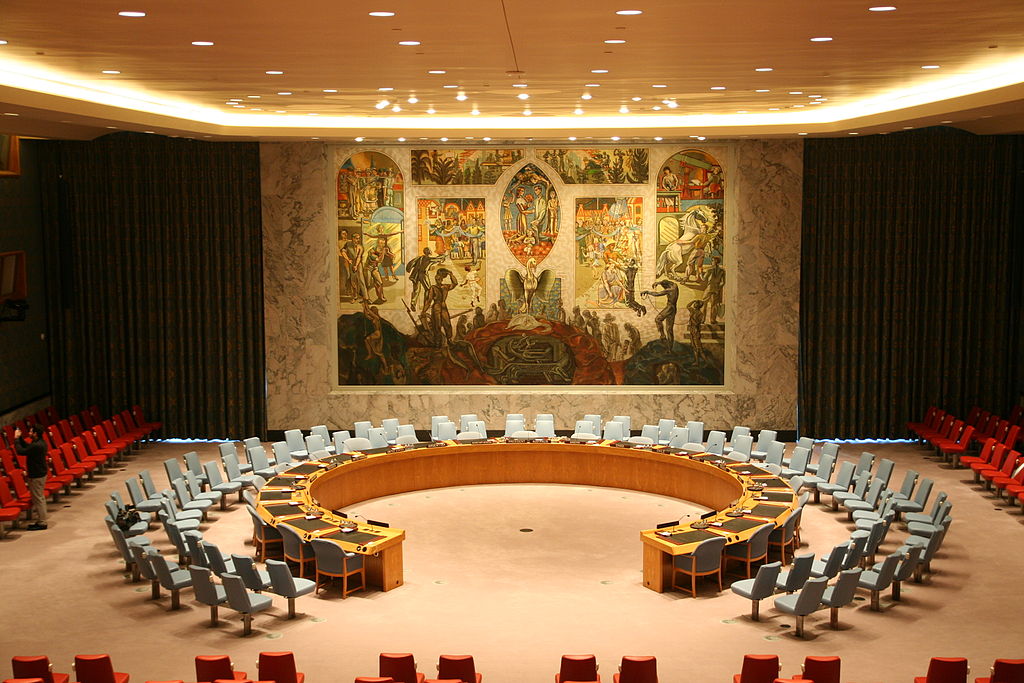Do Iran's New Space Launchers Violate International Law?
On Jan.

Published by The Lawfare Institute
in Cooperation With

On Jan. 3, Secretary of State Mike Pompeo issued a preemptive warning to Iran, stating that its development of three space-launch vehicles “demonstrate[s] Iran’s defiance of UN Security Council Resolution (UNSCR) 2231”—the 2015 resolution endorsing the Joint Comprehensive Plan of Action (JCPOA) or “Iran deal”—on the grounds that the technology used in space-launch vehicles is “virtually identical to that used in ballistic missiles, including in intercontinental ballistic-missiles (ICBMs),” which Security Council Resolution 2231 allegedly prohibits. Shortly thereafter, Iranian Foreign Minister Javad Zarif tweeted the following:
Iran's launch of space vehicles—& missile tests—are NOT in violation of Res 2231. The US is in material breach of same, & as such it is in no position to lecture anyone on it. Reminder to the US: 1. Res 1929 is dead; 2. threats engender threats, while civility begets civility.
This is not the first time the U.S. has criticized Iran’s space-launch vehicles, and it’s not the first time Iran has rejected that critique. But who’s right? Does Security Council Resolution 2231 forbid Iran from testing new space-launch vehicles? Relatedly, can Iran readily convert its space-launch vehicles, which are purportedly designed to launch telecommunication satellites into lower orbit, into ICBMs capable of reaching the U.S.?
Before turning to those questions, here’s what we know about the current state of play:
Iran’s Current Space Launch Capabilities
Having established the Iranian Space Agency (ISA) in 2004, Iran successfully developed its first space-launch vehicle, the Safir rocket, in 2009. It’s a two-staged liquid-fuel rocket with the capacity to propel a 110 pound payload into lower-earth orbit, or approximately 217 miles As Iran began celebrating the 30th anniversary of the Islamic Revolution, it used the SAFIR rocket to launch satellite “Omid” into space, making it the 11th country in the world to do so after the Soviet Union launched the first satellite, Sputnik, in 1957. While Omid was officially launched to enhance Iran’s phone and internet access, the Obama administration nonetheless issued a statement expressing “acute concern” with Iran’s “efforts to develop missile delivery capability.”
Over the subsequent six years, Iran launched three additional satellites using the Safir rocket: the Rasad in 2011; the Navid in 2012; and the Fajr in 2015. Like Omid, these satellites were fairly small in size—ranging from 33 pounds in the case of Rasad to 110 pounds in the case of Navid and Fajr. None of these satellites was launched higher than 248 miles.
During this time, Iran continued to develop a second liquid-fuelled rocket, the Simorgh (“Phoenix”), with the goal of developing a space-launch vehicle with a greater potential payload and orbit than the Safir. U.S. intelligence agencies first reported a test of the Simorgh in April 2016, though it did not reach orbit. A second test occurred in July 2017, which the Pentagon reported as a “catastrophic failure,” though contrary reports in the Iranian media stated that the Simorgh could successfully place a satellite weighing up to 551 pounds in an orbit of 310 miles In August 2017, the United States, along with France, Germany, and United Kingdom, co-signed a letter to the U.N. Secretary General where they condemned Iran’s July 2017 launch, describing it as inconsistent with UNSCR 2231.
On Jan. 1, Iran announced that it plans to send Payam, a 198 pound non-military satellite, into a 310 miles orbit using the Simorgh rocket sometime in the coming months. This Tuesday, Iranian state media announced that the Payam satellite failed to launch, having reached problems in the third stage of the launch. Iran’s telecommunications minister, Mohammad Javad Azari Jahromi, tweeted, “I would have liked to make you happy with some good news, but sometimes life does not go as expected.” Meanwhile, another satellite, Doosti, is waiting to be launched. While we do not know when, it could possibly happen in a few weeks to coincide with the 40th anniversary of the Iranian revolution.
Iran’s Legal Obligations
The United States has long been critical of Iran’s ballistic missile program, citing it as a reason to withdraw from the JCPOA in May 2018. At the U.N. Security Council meeting this past December, Secretary of State Mike Pompeo described it as a “proliferation spree. ” Iran has more ballistic missiles than any other country in the Middle East, with over ten ballistic and cruise missiles (not including space-launch vehicles) in operation or development. Nonetheless, Pompeo’s Jan. 3 statement belies the fact that UNSCR 2231 does not clearly require Iran to refrain from developing space-launch vehicles.
The U.N. International Court of Justice (ICJ) expounded on what interpretive guidelines apply to U.N. Security Resolutions in a 2010 advisory opinion, which evaluated whether Kosovo’s unilateral declaration of independence aligned with international law. While treaties concluded between states are traditionally interpreted according to Articles 31 and 32 of the Vienna Convention on the Law of Treaties, the ICJ said in no uncertain terms that the Vienna Convention did not necessarily encompass Security Council resolutions given the altogether different process through which those documents are written. While the Vienna Convention might inform the court’s interpretation of those resolutions, the court said that “other factors” also apply, including “statements by representatives of members of the Security Council made at the time of their adoption, other resolutions of the Security Council on the same issue, as well as the subsequent practice of relevant United Nations organs and of States affected by those given resolutions.”
In practice, experts on international law typically look for three elements to ascertain if a Security Council resolution is legally binding on states: 1) whether the resolution includes a finding or determination that there is a “threat to international peace and security;” 2) whether the Council includes a statement that it is “acting under Chapter VII” of the U.N. charter; and 3) whether the verb “decides” appears in the relevant operative paragraph intended to be binding. Even then, potentially binding Security Council resolution provisions may use traditionally nonbinding language to communicate measures that are precatory as opposed to obligatory. So provisions that satisfy these requirements and employ binding language such as “shall” are generally viewed as establishing international legal obligations, while those employing non-binding language such as “calls upon” or “urges” are not (though even then there are exceptions).
The operative part of Resolution 2231 as it relates to ballistic missiles appears in paragraph 7(b) of its preamble. That paragraph references Iran’s ballistic missile program (described in paragraph 3 of Annex B), stating that the Security Council:
Decides, acting under Article 41 of the Charter of the United Nations, that, upon receipt by the Security Council of the report from the IAEA described in paragraph 5...
(b) All States shall comply with paragraphs 1, 2, 4, and 5 and the provisions in subparagraphs (a)-(f) of paragraph 6 of Annex B for the duration specified in each paragraph or subparagraph, and are called upon to comply with paragraphs 3 and 7 of Annex B. (emphasis added)
Meanwhile, paragraph 3 of Annex B states Iran should not: “undertake any activity related to ballistic missiles designed to be capable of delivering nuclear weapons, including launches using such ballistic missile technology, until the date eight years after the JCPOA Adoption Day or until the date on which the IAEA submits a report confirming the Broader Conclusion, whichever is earlier.” (emphasis added)
On first reading, paragraph 7 begins with the magic words often used to indicate a binding legal obligation—citing Art. 41, which appears in Chapter VII, and using the critical verb “decides.” Nonetheless, in listing which parts of Annex B states “shall” abide by, it does not list paragraph 3 of Annex B. Instead, it says states are “called upon” to comply with paragraph 3—arguably more precatory language.
You might argue the phrase “are called upon” in Resolution 2231 is ambiguous, thereby suggesting a potential legal application. Indeed, when the JCPOA was first signed, then-Secretary of State John Kerry repeatedly said that the U.S. had managed to preserve restrictions on Iran’s ballistic program—securing a victory over Russia and China, who wanted those restrictions removed. That said, weakened language appearing in Security Council Resolution 2231 was a source of common frustration for JCPOA detractors and supporters alike who agreed that it created a big loophole for Iran’s ballistic program. As JCPOA supporter and nonproliferation expert Jeffrey Lewis explained at the time, “[I]t probably makes sense to think about a follow-on agreement limiting Iran’s development of ballistic and cruise missiles as well as how to deal with a deteriorating regional security situation that has many U.S. allies understandably nervous.”
Interesting, before U.N. members passed Security Council Resolution 2231 in 2015, Iran’s ballistic program was governed by Resolution 1929, which did contain presumably binding language, stating that the U.N. Security Council “decides that Iran shall not undertake any activity related to ballistic missiles capable of delivering nuclear weapons.” (A 2016 Lawfare post discusses the origins of that resolution.) However, that resolution has been completely terminated. Paragraph 7 of Resolution 2231 stipulates that 1929 would not apply once IAEA inspectors independently verified Iran’s compliance with 2231’s requirements in paragraphs 15.1-15.11, which occurred did in January 2016.
Even if the operative text of Security Council Resolution 2231 related to Iran’s missile development were legally binding, it’s not entirely obvious whether the aforementioned provision would encompass either the operational Safir rocket or the Simorgh. After all, Iran is still a party to the JCPOA—along with Britain, France, Russia, Germany, and the EU—and has repeatedly said that it’s not developing the Simorgh to launch nuclear weapons, but rather, to launch non-military space satellites that will presumably enhance its telecommunications. It would therefore stand to reason that, at least at the moment, Iran’s space-launch vehicle is not “designed to be capable of delivering nuclear weapons,” as described in paragraph 3, Annex B. The IAEA issued a November 2018 report and a press release finding full compliance with the JCPOA.
Nonetheless, the phrase should not necessarily be read with respect to Iran’s present intention, According to the 1987 Missile Technology Control Regime, the prevailing international standard for determining whether a ballistic missile possesses “inherent nuclear capability” is not whether the country has a nuclear weapon but whether the missile can deliver a 1102 pound payload at least 186 miles. While the MTCR is not legally binding and certain countries—most notably Russia—argue that the text contained in UNSCR 2231 should not be interpreted by it, it’s perhaps arguable that Iran’s space-launch vehicles might be soon capable of delivering a 1102 pound payload at least 186 miles. At the moment, however, that does not seem to be the case. Indeed, the Simorgh rocket has yet to successfully launch the Payam satellite into space, which is believed to weigh only 198 pounds.
In December 2018, the U.N. released its sixth biannual report on the implementation of Resolution 2231. Section IV of the report cited violations of Resolution 2231 by Iran using what the report calls “category 1” ballistic missiles—that is, missiles capable of carrying a 1102 pound payload a distance of 186 miles or more, as reported by the Permanent Representative of Israel. That said, none of these cited violations pertained to Iran’s space-launch vehicles.
Making a space-launch vehicle into an ICBM
Legal arguments notwithstanding, is Pompeo right when he says that Iran could easily use its space-launch vehicle program as a cover to develop an ICBM, which have a minimum range of 3417 miles? The short answer is yes. In 2013, the National Air and Space Intelligence Center published a report which said that Iran’s Simorgh space-launch vehicles could “serve as a test bed for developing ICBM technologies.” The agency restated its claim in 2017.
Having consulted a few rocket scientists in the U.S. and U.K. for their take, there does not seem to be much debate that Iran’s space-launch vehicles could indeed be converted into an ICBM, at some point. It’s simply a matter of increasing velocity and figuring out how to direct the missile with precision. In a paper for the International Institute of Strategic Studies (IISS), Michael Elleman similarly explained that the Simorgh, whose range is currently estimated at 310 miles, could have a larger hypothetical range reaching up to 3728 miles, if it were fitted with a smaller payload. While it’s not clear how small a nuclear payload Iran could produce in the event of the JCPOA’s dissolution, it’s hypothetically possible to produce a payload weighing less than the Payam. In the 1950s, for example, the U.S. developed a tactical nuclear warhead (W-54), weighing less than 66 pounds.
Scientific hypotheticals aside, it’s worth emphasizing that no country has transformed a liquid-based space-launch vehicle into a long-range ballistic missile to date. Indeed, the technology transfer usually works the opposite way, given how much easier it is to develop ballistic missiles than the full-blown space programs. Elleman explained that even though the Simorgh could have a larger range, it wouldn’t easily become “an operationally viable weapon system.” He goes on to explain that Simorgh, which weights an estimated 80 tons, is “too large… to be deployed on transporter erector launch (TEL) vehicle” and “requires many hours of preparation before it can be launched.” In the event that Iran did want to repurpose the Simorgh, he continues, Iran would be “unacceptably vulnerable to pre-launch interdiction by US forces.” By way of analogy, John Drew of the U.K. Space Operations Centre explained to me that the Semyorka R-7 that sent up Sputnik, despite being an ICBM, was never operationally viable as one. “It was too unwieldy, took too long fuel up, etc. If there was any inclination it was going to be used, the Americans would have taken it out.”
So far, Europe has maintained support for the JCPOA, all the while assuming a tougher approach on Iran’s missile program, citing Iran’s illegal transfer of intermediate ballistic missiles to Houthi rebels in Yemen as well as Shia militias in Iraq. In August 2018, French Foreign Minister Jean-Yves le Drian said that Iran “cannot avoid” talks on its missile program. Furthermore, at the U.N. Security Council meeting in December, Britain’s ambassador, Karen Pierce, said that Iran cannot “expect to improve its relations with the rest of the world or ensure its economic prosperity and security while pursuing its current path.” Whether the U.S. can convince Europe that it needs a second deal related specifically to missiles is hard to predict. In the meantime, Iran will continue to develop its space-launch vehicle program and, U.S. rhetoric notwithstanding, it has no obligation under Security Council Resolution 2231 to stop.





